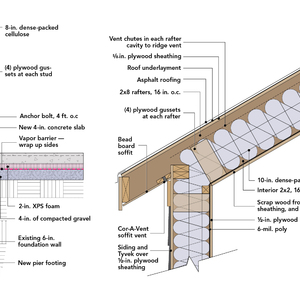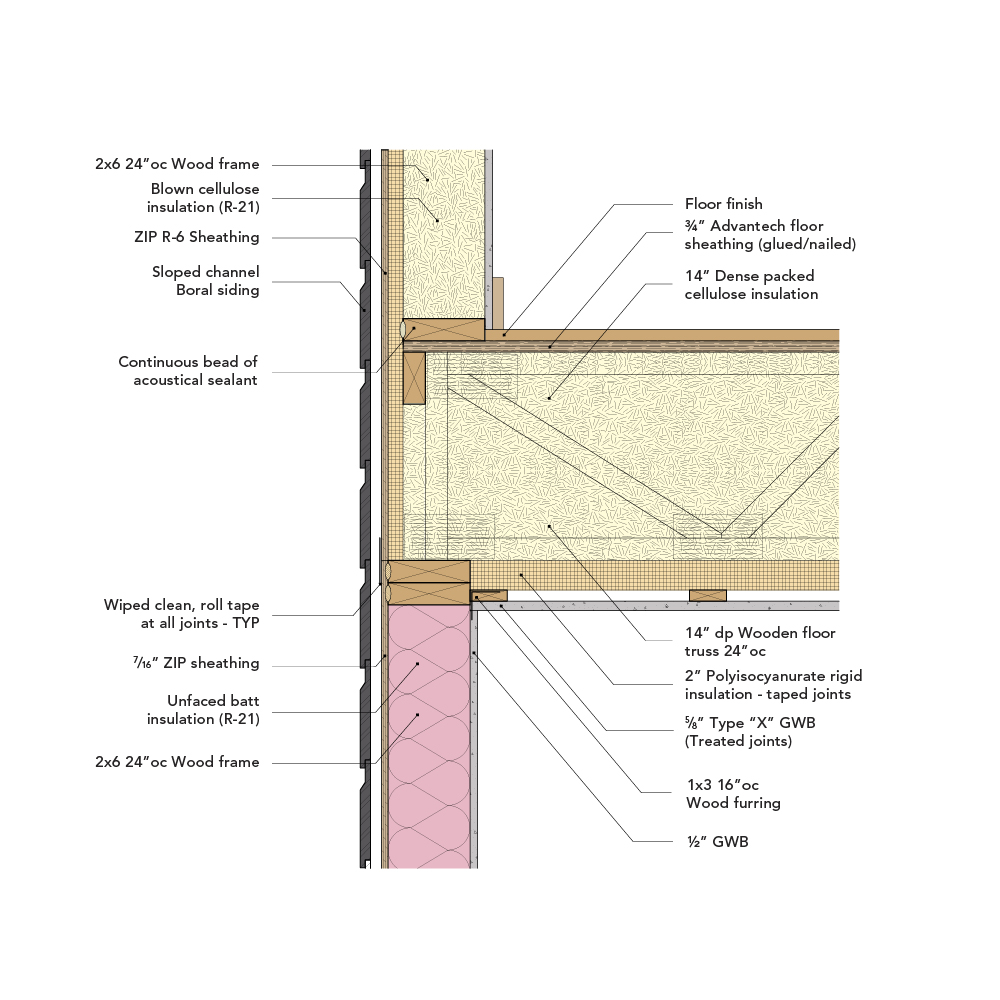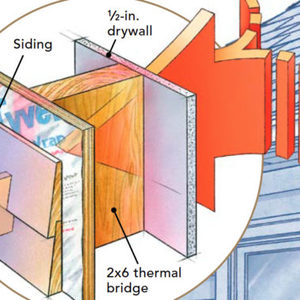
When dealing with water, air, vapor, and thermal control layers, continuity should always be front of mind. The success of any structure relies on our ability to control what happens to the structure itself and the spaces within.
When looking at a typical house with an attached garage, the house takes priority, as it is the inhabited conditioned environment. Often, one or more of its walls abut an unconditioned garage. The intersection between the two structures is what this detail addresses. In this case, it is a 2×6 wood-framed garage wall intersecting a 2×8 exterior house wall.
Water management is the first order of priority. Here, the 1×3 wood furring rainscreen turns the corner from house to garage, thereby maintaining continuity. This furring was selected for several reasons. First, the 3/4-in. space provides ample drainage for any bulk water that gets behind the siding. That gap also creates drying potential for the wall assembly, as air is able to migrate vertically and assist with drying. Lastly, 1×3 wood furring was the general contractor’s favored approach.
The second priority is air tightness management. The 1/2-in. ZIP sheathing with taped joints serves as the primary air barrier. Note that sheathing runs continuously across the exterior of the 2×8 house wall. When developing a strategy to ensure continuous control layers, we do the “red line test” to determine whether or not a space is inside or outside of the conditioned space. In this instance, the house is inside the conditioned space, while everything to the outside of the ZIP sheathing is outside the conditioned space. Notice the sheathing is not interrupted in any way. It is installed as the primary air barrier, and all subsequent materials are attached outboard of it.
Vapor management is third on the list of priorities. In this detail, although the garage is…
Weekly Newsletter
Get building science and energy efficiency advice, plus special offers, in your inbox.

This article is only available to GBA Prime Members
Sign up for a free trial and get instant access to this article as well as GBA’s complete library of premium articles and construction details.
Start Free TrialAlready a member? Log in















8 Comments
An unconditioned attached garage in my very cold climate (climate zone 7) will stay above freezing for most of the winter if it's insulated. Snow and ice covered vehicles can create high humidity levels inside the attached garage which I've seen move into the conditioned home. I've also seen this moisture move up into a conditioned bonus room over an attached garage where it condensed on an exterior wall destroying the OSB sheeting on the north side. Alexandra nailed the wall details for any unconditioned, attached structure, including a sunroom or 3 season porch. When dealing with an attached garage, a few other concerns I stress are; deal with the bulk water, in my market, that's a floor drain. Also needed is vapor control, many new homes in my area with conditioned attached garages are getting dedicated HRV's but exhaust only or a dehumidifier will work as well. Great article on an often overlooked subject!
Randy, all great points, always a pleasure to have your comments!
High performance details are more likely to be implemented if they respect the established sequence of construction. I'd like to see this thought through so that the framing didn't need to be interrupted to apply exterior insulation between the two spaces. On most builds these tasks are performed by separate trades.
More generally: I'm really enjoying this series of blogs but wish Alexandra would revisit them for a few weeks after they appear and answer the questions that are posted.
I had similar concern about the sequencing of the polyiso installation. I think a fair compromise would be to maintain continuity of the Zip for airtightness of the house, but terminate the polyiso at the framing intersection. This would also alleviate the (minor) discontinuity of the garage WRB where it would have to terminate at the outside face of polyiso rather than at the house WRB layer.
I always appreciate seeing details like this -- It clues me in to how others prioritize their solutions and opens up good debate. Great article, keep them coming!
That is valuable feedback, Malcolm. I will request that she do that, when possible.
Malcom, I respectfully acknowledge your comment but we have done this detail numerous times and we have never had a framer question putting a small piece of rigid insulation on the house wall prior to framing the garage. Sometimes new solutions force us to rethink the sequence of construction. The important thing is that the architect or designer is on the same page with the GC and the framer.
In reference to me revisiting, times are extremely busy in the office and will provide a better effort at revisiting.
Alexandra,
If these details are g0ing to cross over from the rarified world of high performance building into the much larger mass market where they may have much larger impact, a few concessions may be necessary. I'm not sure the small piece of insulation between the house and garage framing is important enough to trouble the framers about - and it's presence would cause some real problems out here in seismic-land.
I'm extremely grateful for this blog series. Just hoped to prod you to engage with the ongoing discussion if you have the time.
What are the reasons why we need exterior insulation to keep the house sheathing warm to avoid condensation on the inside surface, but we don't worry about this on the garage? My first thought was that people aren't living in the garage making humidity, but there are wet cars, and there's not continuous ventilation. Typical lower temps in the garage are probably helpful. You mention that gypsum sheathing in the garage can dry to the inside, but that is also the case in a house with latex paint as the class III vapor barrier, and it still needs a certain amount of exterior insulation in a cold climate.
Log in or become a member to post a comment.
Sign up Log in